Star Trek is an enormous and complex cultural entity whose impact on politics, technology, and storytelling are undeniable. It’s also as flawed and problematic as any other massive media franchise. Lifelong Trekkie and Deadshirt Editor-in-Chief Dylan Roth attempts to make sense of it all for die-hards and outsiders alike in his bi-weekly column: Infinite Diversity.
“Think of it: five years ago no one had ever heard of Bajor or Deep Space 9. Now, all our hopes rest here.”
– Gowron, Chancellor of the Klingon High Council (“By Inferno’s Light” [DS9])
Pre(r)amble
Welcome to a new recurring sub-feature of Infinite Diversity: SUFFICIENTLY RANDOMIZED, in which I have a computer select one of the 728 existing Star Trek episodes and films at random, and then I must write about that episode at length. Every episode of the five live-action series, plus the animated series and the twelve feature films, is eligible, and wherever the proverbial die lands, that’s where I have to go. The only times the rule can bend is if the episode chosen is part of a two- or three-part episode or arc, in which case I have to do the entire arc. In the unlikely event that I land on the same episode twice, I’m not required to write about it again.
As you can imagine, I was a little nervous about this first Sufficiently Randomized, because the Trek canon as a whole is sort of a minefield; I could have easily been stuck with an awful episode, or worse, a wholly unmemorable one. As it happened, fortune favored the bold and I rolled a 455: “By Inferno’s Light” from Season Five of Deep Space Nine, the second half of a two-part story that’s held up as one of the show’s best. In accordance with the rules that I’d made up only minutes earlier, I watched both “In Purgatory’s Shadow” and “By Inferno’s Light,” and it turned out the be an ideal selection for this column.
The episode (along with the rest of the Trek canon) is currently up on Netflix if you’d like to watch before you read, but as always I’ll be keeping things as accessible as possible even for readers who’ve never seen a frame of Trek. (If you’re a total beginner, I do recommend reading the very first Infinite Diversity, so you have the basic idea of what Star Trek is all about.) So, here we go: the giant-sized maiden voyage of Infinite Diversity: SUFFICIENTLY RANDOMIZED!
DS9 101
As I explained back in our first installment, Star Trek likes to teach about philosophy and ethics, often by crafting allegory to directly represent real life conflict, cultures, or historical events, casting alien cultures in place of the real ones to avoid or even subvert the audience’s biases. (This episode is about racism in America, this one‘s about drug addiction, this one‘s about AIDS, and so on.) With a few exceptions, Deep Space Nine doesn’t really function that way. There are very few “message episodes.” Instead, Deep Space Nine is more concerned with heavy/heady themes, telling stories that are grander in scope but also more personal and character-driven. Instead of trying to convince you of an opinion or a philosophy each week, DS9 simply gives you a story and the tools to interpret it as you choose. It’s the Star Trek work in which you’re most encouraged to sympathize with a villain, or to question the heroes’ choices. Despite being the third of five live-action series in the franchise, it’s by far the closest Trek has ever gotten to modern prestige-format television.
Also unlike most Star Trek television series, Deep Space Nine has an intricate ongoing storyline that runs through all seven seasons. There are plenty of stand-alone episodes, but more than any other Trek entity, it really pays to watch in sequence. This is definitely the case for today’s story, a pivotal two-part mid-season WHAM episode that sets the stage for just about everything that follows. As great as this two-parter is, I probably wouldn’t recommend “In Purgatory’s Shadow”/”By Inferno’s Light” as anyone’s first Deep Space Nine episode; there’s just so much to unpack. Fortunately, I’m here to guide you through it, to explore its many facets, and have some fun along the way. Here’s our story so far:
Deep Space 9 is a space station on the far reaches of Federation (Earth & allies) space, in orbit of an independent world called Bajor. For generations, Bajor was occupied by the Cardassians, a race of cunning, militaristic snake people, but they were eventually chased away by the Federation and Bajoran resistance fighters, so now Bajor, and its orbiting space station Deep Space 9, are under the Federation Starfleet’s protection. DS9 is home to a large, diverse population of Starfleet and Bajoran officers, and civilians from just about everywhere. It’s essentially an Old West town in space.
Since Benjamin Sisko arrived as the station’s first Starfleet commander, DS9 has gone from a backwater outpost to one of the Federation’s most important strongholds. It’s positioned at the mouth of the recently-discovered Bajoran Wormhole, a stable portal between the Alpha Quadrant (where most Trek takes place) and the far-off Gamma Quadrant, home of a conquering empire known as the Dominion. Since first encountering the Dominion, Sisko and his crew have been preparing to hold the line against the inevitable invasion, but the Dominion is incredibly calculating and is waiting for the right moment to strike.
Has that moment finally come?
“In Purgatory’s Shadow“/”By Inferno’s Light” (DS9)
Season Five, Episodes Fourteen & Fifteen
Written by Ira Steven Behr & Robert Hewitt Wolfe
Directed by Gabrielle Beaumont (pt. 1) & Les Landau (pt. 2)
Plain, Simple Garak
The main plot of “In Purgatory’s Shadow” mainly concerns recurring character Elim Garak (Andrew Robinson), a former Cardassian spy who is exiled to DS9 before the start of the series. Garak is a fan-favorite character for a reason: in a universe where most characters (good or evil) are pretty shallow and forthcoming, Garak is enigmatic, a true anti-hero. He’s sort of a less sexy prototype of Battlestar Galactica‘s Gaius Baltar—he’s not good, he’s not evil, he’s just out for himself, and he’s unpredictable. Half of what he says is a lie, and you don’t always learn which half by the end of the episode. He helps the Starfleet crew when it suits him, and frequently manipulates them into helping him complete his own goals in the process. Most of the crew sees Garak as a valuable asset, and some of them even genuinely like him, but nobody trusts him, and he wouldn’t have it any other way.
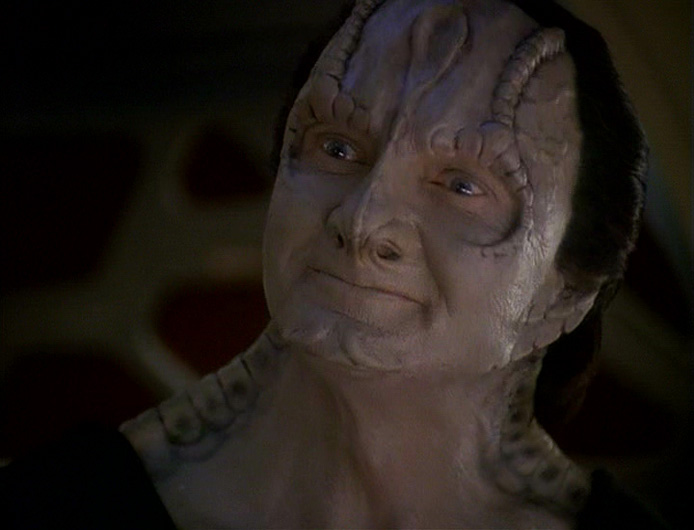
“Lying is a skill like any other. And if you want to maintain a level of excellence, you have to practice constantly.”
“In Purgatory’s Shadow” begins when DS9 receives a coded Cardassian transmission from one of their listening posts in the Gamma Quadrant, where, as far as they know, there are no Cardassians—at least not since their disastrous preemptive strike against the Dominion homeworld two years ago. Garak confirms that the message is from Enabran Tain, Garak’s mentor and the former head of the Cardassian intelligence agency that Garak once served. Tain is also the man who led the failed invasion, and is presumed dead along with all the rest of his fleet. Garak convinces Captain Sisko to allow him to venture into the Gamma Quadrant to search for Tain and any other survivors, and Sisko agrees—but he’s sending Worf with him.
You know Worf. He’s the big scary guy who was on The Next Generation. He’s on Deep Space Nine now. If you don’t know Worf, here’s what you need to know: he’s a top-shelf Klingon warrior who values honor and loyalty above all. He’s the anti-Garak.
Garak and Worf successfully find the source of the transmission, and by “find the source of the transmission” I mean that they get ambushed, captured, and sent to the very same POW camp asteroid from which said transmission originated. There, they do indeed find Enabran Tain (along with some other familiar faces—we’ll get to that), who’s on his death bed. In the sort of last will and testament only a spymaster could muster, Tain lists off the names of his many rivals, and Garak assures him that he’s already dispensed with each one of them.
Is it true? We’ll never know. Perhaps Garak really has been hard at work killing or ruining all of Tain’s old foes since the old man disappeared, and now he wants credit for his loyalty, or it could be that he just wants to make Tain feel better about dying. What Garak really wants, what he’s wanted his whole life, is for Tain to acknowledge the truth: Tain is Garak’s father. Garak gets his wish, but it’s as bittersweet as victories get. Tain expresses a modicum of pride in his son (which, coming from him, means everything), and then dies.
In “By Inferno’s Light,” Garak’s struggle is more physical; in order to complete his late father’s escape plan, Garak must squeeze into a dark, cramped crawlspace and reprogram a life support system. The wrinkle: Garak is very claustrophobic. While he gets far less screen time in part two, Andrew Robinson makes his moments count, as his typically hammy character stammers a pep talk to himself while fighting back a panic attack. Garak’s willingness to confront his greatest fear impresses even Worf.
While there are plenty of contenders for Best Garak Episode (nearly all of them are wonderful), “In Purgatory’s Shadow” would get my vote. The story highlights everything that makes Garak so fascinating and memorable as a character: his duplicitous nature, his insecurities, his unlikely capacity for heroism, and his sense of humor. Star Trek sometimes suffers for its broad, stage-y acting, but for Andrew Robinson’s Garak it just works. He’s over the top, and yet, he’s totally real. Sometimes you laugh with him, sometimes you’re scared of him, sometimes you feel sorry for him, but you’re always captivated. He’s Mr. Silva from Skyfall, in space.
Victory is Life
While he’s mostly a comedic foil for Garak in part one, Worf gets a pretty cool story of his own in “By Inferno’s Light.” While held prisoner at Internment Camp 371, Worf is forced to fight against the Jem’Hadar guards, over and over, so that their soldiers can train for their inevitable war against the Klingons. Worf can’t turn down a challenge, so he fights. When he defeats their first warrior, they send in another, stronger, more experienced one. He is, again, victorious, and the fights keep coming. Over what appears to be the space of two days, Worf defeats seven consecutive Jem’Hadar warriors. His fellow Klingon captor, General Martok, is awestruck, sparking a friendship that lasts for years. But more than that, Worf even wins over the leader of the Jem’Hadar guards, Ikat’ika, after Worf refuses to yield despite being barely able to stand at the conclusion of fight number eight. With his opponent at his mercy, Ikat’ika declines to finish Worf off.
“I cannot defeat this Klingon,” Ikat’ika announces to his men. “I can only kill him, and that no longer holds my interest.” For his refusal to take Worf’s life, Ikat’ika himself is executed.
Like the Klingons, the Jem’Hadar are fierce warriors with a strict code, but that’s basically where their similarities end, and I suspect this episode was designed to highlight their differences. The Klingons are famous for their warlike culture and their obsession with honor and glory, but they can also be boisterous. They like to have a good time. They’re individualistic, cherishing their own glories as much as those of the Empire. Theirs is a culture developed over millennia, textured and kind of beautiful.
The Jem’Hadar are the fist of the Dominion, genetically engineered soldiers with no other purpose other than to fight for the Founders, who they worship as gods. It could have been that simple—the Jem’Hadar could have been like Tolkien’s Uruk’hai—scary homegrown footsoldiers with no agency or texture. Instead, they’re one of the more compelling alien cultures in Trek. They’re created with one purpose, and while they can acknowledge or even envy those who can choose their own destiny, they just can’t break ranks and do it themselves. They know their role, and they’re helpless to change it. They’ll fight and die for the Founders, because that’s what they were made to do and they don’t know how to do anything else.
They’re programmed to obey the Founders and their agents, the Vorta, no matter what, and they nearly always do. But while their loyalty to the Founders is unquestioned, they sort of hate the Vorta. The Vorta are slippery, treacherous bastards who don’t value the lives of the Jem’Hadar at all. The Jem’Hadar aren’t really supposed to value themselves, either; they’re expected to run straight into certain death if that’s what the Vorta tell them to do, and they will do it, but they’ll be sort of bummed about it. It’s common for a Jem’Hadar field commander to vocally disagree with his Vorta handlers’ orders, and then carry them out anyway, with this look on his face that says “what a waste.” This transforms the Jem’Hadar from autonomous safe-to-kill-on-TV goons to tragic figures of sorts, victims of their masters’ thirst for conquest and control.
Impostors!
The leaders of the Dominion are the Founders, also known as the Changelings, and you can probably guess why. In their natural state, the Founders are just an ocean of goo, made up of a bunch of individual, sentient puddles of goo that can transform into perfect facsimiles of other life forms or objects. The Founders routinely remove and replace high-ranking members of enemy governments and fleets, weakening them through subterfuge and sabotage and setting them up to fall to their more direct Jem’Hadar forces. Despite years of trying, the Federation still doesn’t have a reliable way to detect Changeling infiltrators, meaning the enemy could be anyone and they’d likely never know until it’s too late.
When Worf and Garak arrive at Internment Camp 371 and find Tain, they also recognize two other inmates. The first is General Martok, a high-ranking Klingon officer whose Changeling replacement set the Empire on a path to self-destruction before being discovered and killed. This is our first time meeting the real Martok, who’s been held here for the past two years. He’s spent that time fighting the Jem’Hadar in one-on-one duels, which cost him an eye (though he probably doesn’t mind that so much because it looks badass). He laments the damage caused by his doppelganger, but at least he knows it’s all over now.
But what about their remaining cell-mate? Why, it’s—
It’s DS9’s Dr. Julian Bashir, who we just saw aboard the station! That means the Bashir we’ve been seeing up to this point in the episode is a Changeling imposter, and no one back home even suspects him. That’s scary for a couple of reasons. First, there’s the obvious: Bashir is the Chief Medical Officer for the whole station, responsible for the health of not just the Starfleet crew but the entire civilian population. He’s the doctor. He could probably take out the whole station with a tainted vaccine. He has access to the life support systems. He can go anywhere on board without question. He has the authority to relieve the Captain of duty whenever he sees fit. A saboteur couldn’t pick a better position to take over.
It’s a pretty frightening twist. The first time we see Fake Bashir after his true nature is revealed to the audience, we see the impostor benignly delivering Chief O’Brien and Commander Dax some lunch while they work on an important project. He’s just smiling, making jokes with his buddies, and delivering a plate of food and it’s creepy as hell. He could be spying to see how their work is going. The food could be poisoned. If nothing else, he’s continuing to prove his ability to fool even Miles and Jadzia, Julian’s closest friends. It’s truly eerie.
That’s the other part of what makes the Changeling infiltration angle so terrifying—the idea that you could be kidnapped or even killed, and someone else could be walking around living your life. Your friends aren’t looking for you. They haven’t noticed you’re missing. They like your replacement as much as they like you, maybe moreso, since a spy might be more eager to please in order to avert suspicion. Then, finally, your doppelganger will betray those closest to you, and the last thing your loved ones will see is your face.
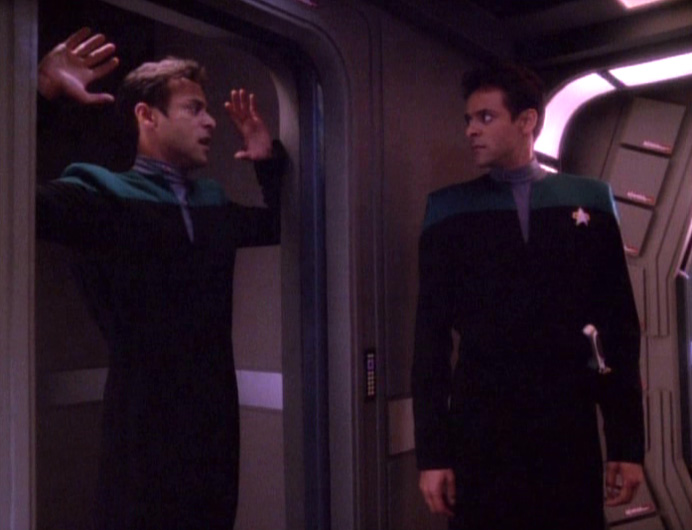
Julian has actually had to face this possibility before, nearly three years earlier, when he’s momentarily replaced by another Changeling.
Sadly, “By Inferno’s Light” fails to cash in on the plot and character potential of Fake Julian. First, the Changeling never takes advantage of the unique opportunities presented by posing as the station’s CMO. His role in the Dominion’s plan is 1) to sabotage the crew’s efforts to collapse the wormhole, and 2) to steal a runabout (one of DS9’s large shuttlecraft) and launch a weapon into the Bajoran sun. Either of these objectives could have been accomplished by posing as a no-name engineer. Aside from being present at senior staff meetings, allowing him to stay one step ahead of them, being Dr. Bashir really didn’t aid in his efforts at all. He might as well have posed as Sisko’s coffee mug for the past month.
Bashir’s capture doesn’t yield any character development, either. When Julian returns home, he and O’Brien have a brief chat about how easily his replacement got along with everyone, and how nobody even suspected for a moment that it wasn’t really him. It’s played for laughs. That’s certainly one way to go with it, but it’s also a missed opportunity for some added character drama. Unfortunately, the fact that Julian was replaced by a shapeshifter and no one noticed is only ever mentioned once more in the entire series. It’s also disappointing that actor Alexander Siddig was only informed that his character had been replaced by an imposter when filming began for “In Purgatory’s Shadow,” even though Julian is apparently abducted before Starfleet adopted its cool new uniforms, four episodes earlier. There’s no evidence that even the writers knew until this two-parter began. Were Deep Space Nine made today, this would probably have been a season-long arc, but sadly this was 1996, and the audience was only expected to juggle so many plot threads.
The Best of the Best of the Best
In many respects, “In Purgatory’s Shadow”/”By Inferno’s Light” marks DS9‘s peak as a series. It’s an enormous turning point for the series mythology, setting up the Dominion War that would dominate the final two seasons. The story highlights all of the series’ best qualities: character drama, political intrigue, space action, and thought-provoking sci-fi concepts. It makes the most out of the show’s increasingly serialized format, and strikes a great balance between giving the audience what it wants and throwing it for a loop.
If this two-parter isn’t Deep Space Nine‘s overall greatest story (that honor goes to either “The Visitor” or “In the Pale Moonlight”), it’s at the very least a great example of everything that sets DS9 apart from the Star Trek pack, and why, of all the series in the franchise, it’s held up the best.
Infinite Diversity will return in two weeks! Follow @DeadshirtDotNet on Twitter to keep up with what’s new here on Deadshirt, and feel free to tweet @DylanRoth with suggestions for future topics for Infinite Diversity, or just to talk about Trek. He truly never gets tired of that.

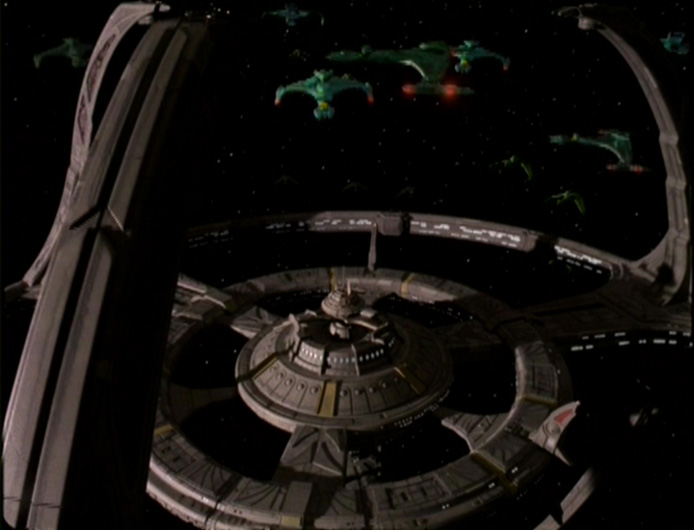
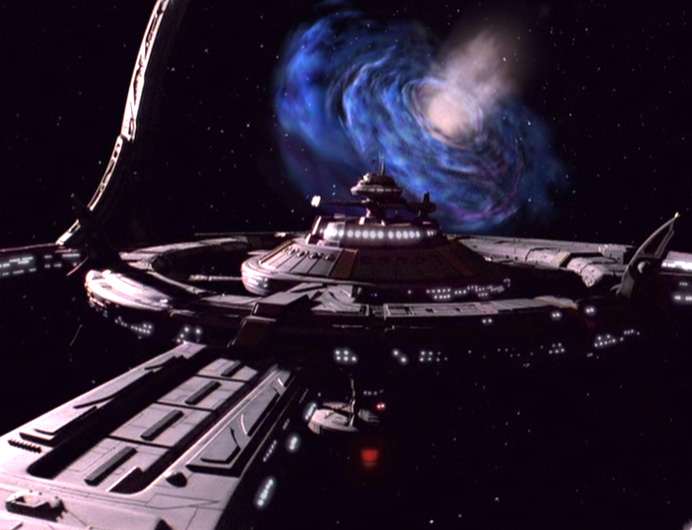
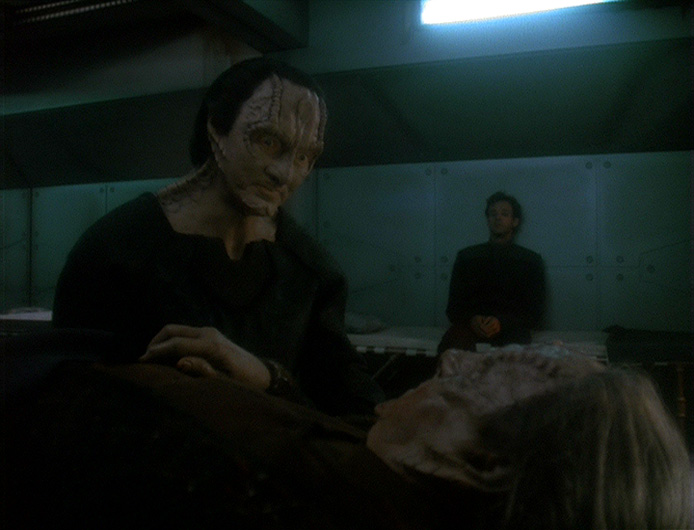
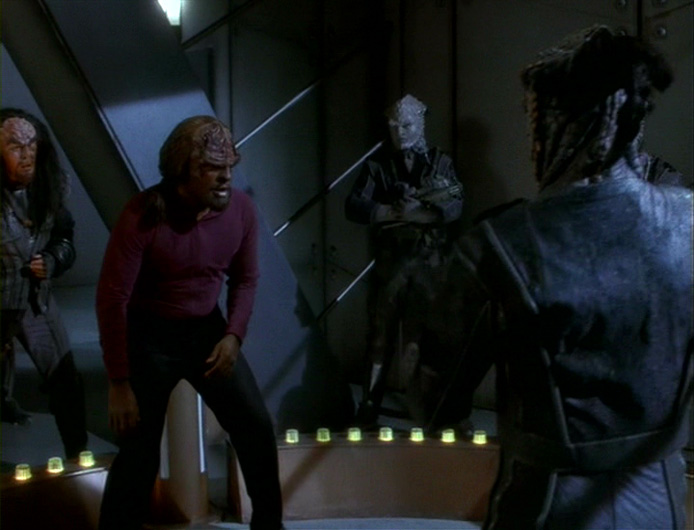
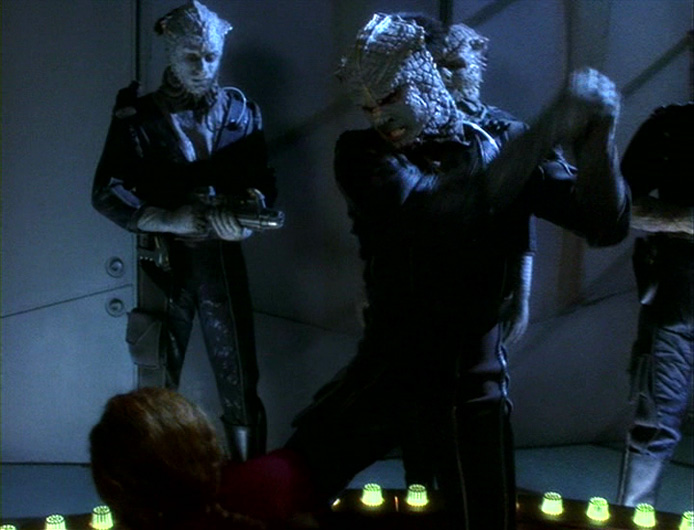
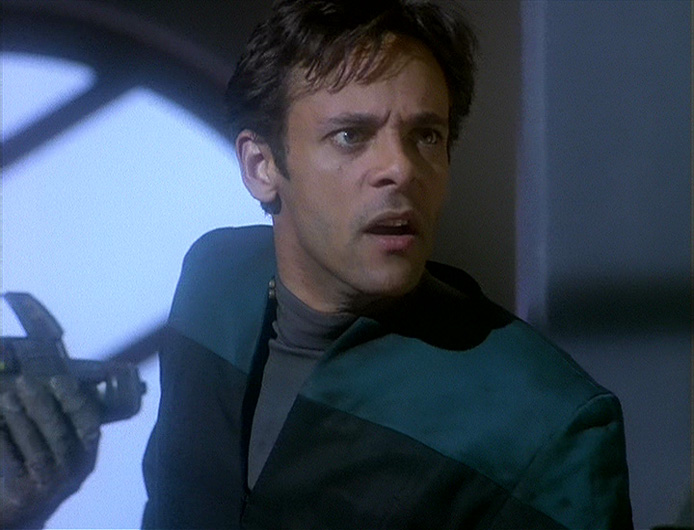

MORE FUN FACTS
-Andrew Robinson is actually claustrophobic and essentially allowed the crew to film his panic attack. (He’s in prosthetic makeup to boot, yeeeeesh)
-J.G. Hertzler suggested the new Martok makeup because he’s actually blind in that eye. He recognized what a cool opportunity that would be because almost no other actor would be willing/able to have their vision further obstructed in prosthetics.
TREK RECURRING ACTORS ARE BADASS YO